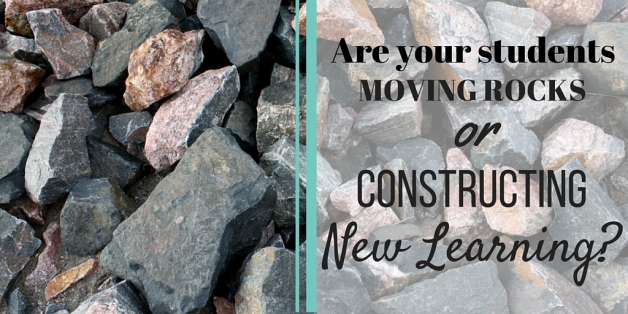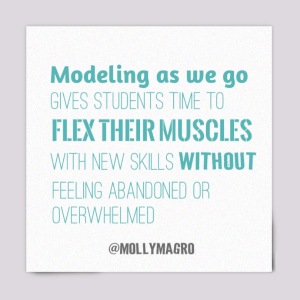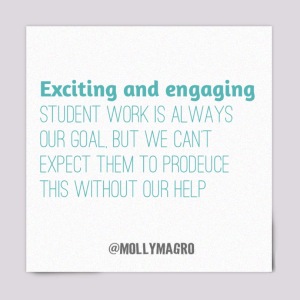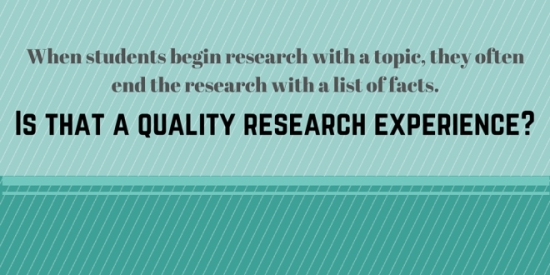Refreshing Classroom Research

When teachers prepare for a research project, the first step in the process is often, “pick a topic.” Early in my teaching career, that is exactly how I would begin. I would assign a topic or let students choose one out of a hat. Then, I would carefully design an elaborate step by step process for students to follow and lead them to a well intentioned, but ultimately trivial, final product. Essentially, I was asking students to move rocks. They would look up their topic in books or online, write their facts on a poster, website, slide, etc. and then I would grade their work. Where was the thinking?
So, what should a research project look like? I continue to hone my vision for student research, and conversations with our building librarian, Molly Magro (@mollymagro), help shape my opinions on this topic. The following are our thoughts on creating relevant and rewarding student research projects.
Start with a question or purpose, not a topic.
Let’s be honest, there are limited scholastic topics that are going to inspire an inner need for adolescents to dive into a research project. Presenting the students with a real world problem can spark interest and set an authentic purpose for learning: Design a working pinball machine proving your understanding of forces of motion as well as circuits (thanks @rosscoops31). We recognize not all curriculum topics lend themselves to an authentic problem, i.e. the Renaissance. This is where engaging students in a questioning process is effective. When students are placed in a situation to ask their own questions about a topic or event, these questions generate personal interest and create relevancy. We like to use the Question Formulation Technique, but any system that gets kids asking their own questions, rather than just answering teacher or textbook-crafted questions, is effective. The key is generating a statement that will elicit questions or spark debate. History can be especially tricky. Find a theme that connects historical content to our current world. Posing a statement such as, “The Renaissance is the most important time period in world history,” will get kids talking. Even students without any background knowledge about the Renaissance will ask questions about that statement. If you don’t believe us, try it!
Teach specific research skills.
 This is where panic can sometimes set in, because many of us would like to have students investigate a topic and present their information to us over the course of, say, a week or so. One of the biggest struggles I encounter regularly as librarian is that every teacher has a different definition of how much time they feel research deserves. Research skills can also be tough because often the classroom teacher, who may not be confident in this arena, will check out a bit and/or seem indifferent to the process. My biggest successes have arisen from teaching mini-lessons I pre-plan with the content area teacher and deliver at the start of each class period students spend researching. This “modeling as we go” technique gives students time to flex their muscles with new skills without feeling abandoned or overwhelmed.
This is where panic can sometimes set in, because many of us would like to have students investigate a topic and present their information to us over the course of, say, a week or so. One of the biggest struggles I encounter regularly as librarian is that every teacher has a different definition of how much time they feel research deserves. Research skills can also be tough because often the classroom teacher, who may not be confident in this arena, will check out a bit and/or seem indifferent to the process. My biggest successes have arisen from teaching mini-lessons I pre-plan with the content area teacher and deliver at the start of each class period students spend researching. This “modeling as we go” technique gives students time to flex their muscles with new skills without feeling abandoned or overwhelmed.
Break it down.
It is most effective to chunk tasks for students. Start each day with a clear goal: “Brainstorm effective keywords, and keep track of the most successful,” or “locate and bookmark two helpful resources, and take some time to read them.” Providing a full day of research direction up front is overwhelming and will most likely create anxiety or boredom, rather than excitement, related to the experience.
Keywords!
Students become attached to their research questions, and their initial instinct is to type their question verbatim into a search engine. Therefore, learning about keyword searches is often our starting point. This is a skill that requires strategic modeling and practice, practice, practice.
Web Site Evaluation
I often remind students that pages of search results in Google are color-coded. The web page is in blue, and the web site is in green. We will then discuss the difference between a web site & a web page, and this is a perfect opportunity to point out how helpful it can be to look at the name of the web site before you click on it! Google even bolds your keywords in their results page, really saving students time if they’ve used them effectively. Ideally, students will locate sources that are about or specializing in their topic, not information farms. Of course, there are many existing acronyms teachers can use to help students evaluate a web site (CRAP or RADCAB are two examples). Typically, we examine currency, authority, etc., and students often want to speed through this process, so I like to highlight a few key strategies, such as looking for an “About this site” page to learn where the information is coming from, and checking whether the page is cluttered with ads or typos and therefore likely not as scholarly. Don’t forget, too, about professional databases your school librarian may subscribe to that are age and reading level appropriate!
Note-Taking Strategies
Reading online to learn is a new skill for our students. Sure, they may often watch videos or read for entertainment, but when it comes to reading a paragraph and pulling out key details, this is a habit that demands modeling and practicing. I love to introduce students to the world of browser extensions and add an ad-blocker, such as Adblock Plus, as well as an annotation & bookmarking tool, like Diigo (here are student friendly tips to get started). Students are often thrilled at the bonus features these tools can offer, and together we will practice bookmarking a web site, adding thoughts & questions via post-it notes, and highlighting new words and important information (note: it is a challenge for many students to determine what is truly important and what is simply extra information. Model this often, and do not assume it’s obvious!) Later, when it’s time to create a bibliography, all of the online sources they’ve used are there for them. I love GAFE, and use them constantly, but Google Docs can be a definite cheat for students when taking notes online. The constant routine of select-copy-paste leaves little room for actual reading and inferencing, let alone putting the information into one’s own words. Paraphrasing is a skill that must be modeled and practiced, and a note-taking tool such as Diigo allows students to select phrases that they will then re-word, rather than copying an entire paragraph. Again, practice this together! Exciting and engaging student work is always our goal, but we can’t expect them to produce this without our help.
Print Sources!
Of course, the Common Core standards suggest that students become adept at using both digital and print sources. As a librarian, I find great joy in introducing students to “that perfect book” that really helps them to connect to their topic via engaging images, on-level text, and up-to-date information. Sometimes, though, students are out of practice using books for research, or just not interested. To combat this, the books we offer them MUST be stellar choices. Dusty and musty and overly academic will not do. Remember to model how to use text features, such as the index, table of contents, bolded headings, etc., just as you modeled web site evaluation and reading online.
Synthesis over product.
Have your students developed a new thought, idea, or connection based on their research? When students begin research with a topic, they often end the research with a list of facts. Even if these facts are streamed into an essay or informational writing piece, they typically still manifest as a regurgitation of content. If we asked a student in one of my former classes why they were doing research, they probably would have replied, “because I am going to make a website.” We often allow our vision of an end product to drive the learning process. In writing, we recognize how silly this sounds, but it is a reality.
Place the focus on the new learning, then think about the best way to present that information. Allow the students to engage in their research experience. Once they have developed a new understanding or connection, ask them what they want to do with it.
During a recent #currichat, teacher Jackie Whiting (@MsJWhiting) proposed a student centered class discussion as a follow up to a research experience. This idea provides a perfect opportunity for students to synthesize their new learning and present it in conversation. Adapting information into dialogue, as opposed to a scripted presentation, adds a level of rigor and purpose to student work. Here is an example of Jackie’s fishbowl discussion, and additional student centered discussion protocols can be found here.
The End Game
Outside of an educational setting, learners are faced with few situations requiring the recall of countless facts associated with a given topic. They will, however, be asked to solve problems, innovate, and appropriately argue a point. These tasks require the ability to not only research a given topic (and locate reliable information) but turn that research into something new. Are classroom experiences providing students the opportunity to practice this transfer? If not, how can we begin to move in this direction?
Additional Resources from #currichat November 4, 2015
via @starrsackstein:
Damn you research! Dealing with the inherent frustration associated with the process
“Of course I know how to Google!”
via @msjwhiting:
Better Searches, Better Results
via @rosscoops31


